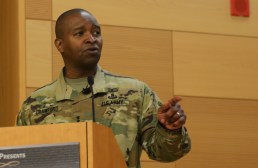Army ITA’s Greg Garcia on innovating with stagnant budgets
https://www.youtube.com/watch?v=T8VeG5s55R4
The solution to tepid budgets and pressure to innovate lies in maximizing the value of every dollar, according to Greg Garcia of the U.S. Army Information Technology Agency. The agency plans to accomplish this through a strategy of network virtualization and compacting sources of data.
“With the [Defense Department] facing sequestration again, there are specific targets to really use every dollar we have available for our warfighting capability of our great Army and our great DOD. They’re really turning to us to consume less and provide the same great level of service,” said Garcia, executive director of ITA. “That really drives this innovation loop. We’re not getting more money, so we have to think differently.”
Critical to this effort will be the gradual phasing out of obsolete legacy systems in favor of more current cloud-based solutions, which Garcia said will reduce cost and increase capability.
“I think that whole disruptive change of the cloud and virtualization — and really, maybe Web apps as opposed to systems approach — is really driving this change,” he said. “There really is some great economics in that that allow us to reap those required reductions in cost while giving that great capability to our warfighters.”
The Army ITA will also work to bolster its cybersecurity defenses as plans to go virtual come under scrutiny in the aftermath of the recent OPM hacks. To this end, the DODis working to enact a broad initiative called the Joint Integrated Environment (JIE) which will standardize systems and collapse posts into joint regional security stacks.
“We can’t build complete networks at every camp, post and station we have. That’s 230-plus instances of something; that gets difficult to afford, difficult to manage and difficult to protect,” Garcia said. “The construct is how do I simplify that network that serves the DOD machine while ensuring robust, coherent security aspects?”
These security concerns will escalate as technology becomes connected in an Internet of Things landscape, which Garcia sees as inevitable.
“It’s not the Internet of Things — it’s gonna be the the Internet of Everything, if you think about it. You’re going to hack into your refrigerator to get to your car — it’s going to be really complex,” he said. “In a mission that’s global, that persistent and prevalent communication is going to be required.”





